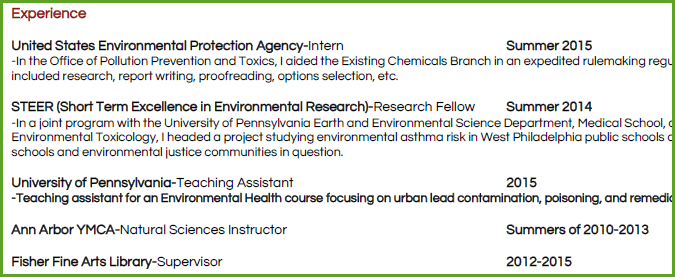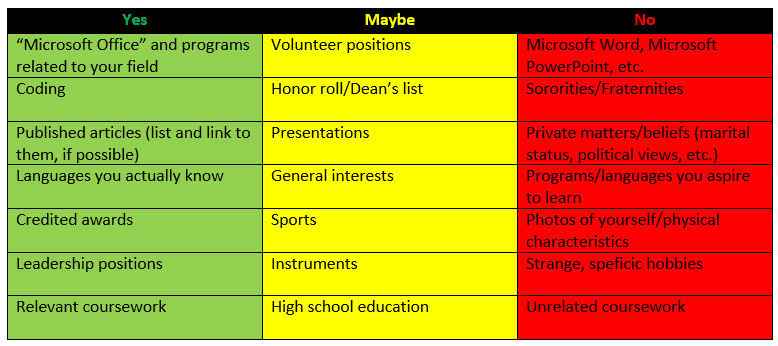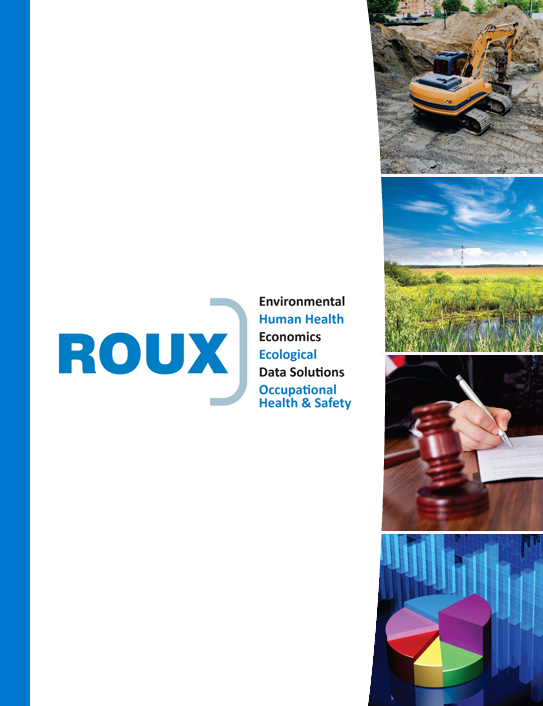Resume Writing, Part 2: Actually Writing/What to Include
By Melissa Nau
Good day again, fellow graduates. Congratulations, because the worst is over. If you’ve made it this far, you already know the basics of setting up your resume and maybe even picked out a nice template. Now I’ll be going through all the parts of a resume and basically write yours for you. Aren’t you glad I’m around?
Resume Writing, Part 2: Actually Writing/What to Include
Let me preface this by highlighting the importance of font. Script and bubble letters are not appropriate for your resume, even if you work with children. Your size range should be 10-12 with fonts like Times New Roman, Arial, Veranda, or Calibri if you’re feeling exotic. Your exact size depends on your font. If you have to squint, try again. An employer may be going through your resume with a fine tooth comb; they do not want to hold a magnifying glass in their other hand.
Next off, we have your header. See the picture below for the absolute basic essentials: Name, Phone number, Email, and Address. However, as discussed previously, you may be putting your resume on sites like CareerBuilder in order to be reached by potential recruiters, so you do not necessarily want to include your full address. Mine only has City, State. You may feel uneasy about having your phone number plastered on the Internet as well, but if this is the fastest and easiest way for someone to contact you, it should appear on your resume. Personally, I have not received any “scam” phone calls from having my resume on job sites. Above all, you must list at least one contact method so employers can reach you. I’d recommend listing everything below:

Additionally, you may want to incorporate a link to your LinkedIn profile in your header. LinkedIn should be an extended version of your resume. Employers will likely look you up on LinkedIn anyway, so they will appreciate if you save them some time. You can write something like “View my LinkedIn profile” and highlight “LinkedIn,” on Word, right click to Hyperlink, and add the link directly to your page. When you PDF your resume, employers will be able to click through to the link directly. You can find this link if you view your profile page, directly under “View profile as.”

Once your header is done, you can start thinking about/formatting your actual sections—which remember, you’re fitting to one page. These should act as the core foundation of your resume, so I’ll dedicate some time to explaining each of them:
- Objective
- Education
- Experience
And, depending on the space you have/what is most relevant to the position you want, a couple extras, including:
- Skills
- Awards
- Relevant Coursework
- Publications
- Extracurricular/Volunteer Work/Leadership Experience
- Interests
Objective
While an objective is not 100% necessary in the same way that your Education and Experience are, it’s certainly a nice touch and should only be about a sentence or two. An objective should be exactly what it sounds like: your objective. What do you want to get out of this job? Why do you want it? What are some key words you can add in to really get across your interest/make you stand out from other candidates? Let’s look at some real resume examples below:

Here is an example of an objective, but not a particularly good one. Primarily, I’d advise against the red text and the small font size. Content wise, it’s extremely vague and does not identify the field the person is interested in. Improving one’s self and gaining life experiences are okay personal goals, but not necessarily career oriented. If you write an objective, be specific, and don’t be afraid to state exactly what you want:

The above objective is a lot more specific and more likely to capture an employer’s attention. Not only does this person want to be challenged, but they have “passion” for a specific field (environmental geology) and they are targeting a particular job market (environmental companies). Perhaps the best part of this objective is the fact that the person mentioned they’d “add value” to their potential employer. If your objectives/goals are not all about you, employers can already tell that you’re a team player.
To further specify and tailor your objective to the job you’re looking to apply to, feel free to alter your statement depending on the application. If the company’s job listing is emphasizing safety, for example, you could rewrite the above objective as such: “To obtain a challenging role in an environmental company to further pursue my passion in environmental geology and use my geological knowledge to add value to my employer, while implementing my safety training to benefit overall company operations.”
At Roux Associates our Recruiting Director reads every resume carefully, but it’s important to realize that not all companies do this. The rumors are true: most companies do use software that scans your resume for a predetermined set of words and phrases. Luckily, those words are exactly what they ask of you in their “qualifications” section—it’s your job to match your lingo to theirs, as long as you’re not lying about your qualifications.
Education
Just like your parents told you, Education comes first (only second to your Objective, if you have one). Many of the jobs you’re applying for likely require the degree you’ve just earned. This resume features degrees/programs in bold; you can bold your schools instead, but do not bold both. I prefer making the degree bold since it’s almost always the first thing your employer looks for. They will then look for name recognition (to see if they’ve heard of your schools and companies you’ve worked for) -> recognition of job titles -> the dates (how long you’ve spent at each school/job) -> and finally, the overall way your resume is written/presented. Remember, a computer can pull out key words from your resume, but it cannot interpret your character.

With this formatting, employers can quickly glance back and forth and take note of dates right away—make sure the date is not jumbled within the rest of your content. You can pick out awards and recognitions associated with your schooling, or you can move these into an “awards” section if you have more than one/have the room to do so. Please note that “magna cum laude” takes the place of a numerical GPA; do not list both. Remember, the goal of your resume is to fit as much as you can while staying relevant to the job you want, which should include cutting out any and all redundancies. Overall, your education needs to include: your date/expected date of graduation, your degree, the school itself, and your concentrations.
Experience
Listing your relevant work experience is one of the most important parts of your resume. Your most recent degrees are likely closely related to what you want in a career, so it’s best to list them from most to least recent. Job experiences may be different, though. You’re right out of college and you have to survive—you likely have/had a recent job that isn’t directly related to your degree. Because of this, you should opt to list the jobs or internships you’ve had that are related to your job field first, even if they’re not the most recent. You should also retain the same formatting as before—bold the job itself like you did with your degrees, and list the corresponding dates on the right:

Above is a good example of formatting a relevant internship. While listing the hours is uncommon, it indicates an impressive timeframe, breaking down to 8-hour days three days a week for the whole semester. The description is a thorough list without having to be written in full sentences, verbs are in the present tense, and there is no mention of pronouns (i.e. I did this, I did that). While there are four description lines here and you may not have room for that, the first bullet could suffice on its own. This person is likely looking for a job that requires these skills: copyediting, proofreading, fact checking—and all are included on the resume as potential “key words” for a resume screening.

The second example above falls a bit short. While the job itself is from a more recognizable agency, the candidate left out the location of the internship, a specific time frame, the formal job title (I’m sure it wasn’t just “Intern”), and ends their description with “etc.” If you went out of the way to make your margins that wide, you should take the time to fill out each line with as much content as you can fit. This graduate could have said a lot more of this interesting internship; the use of “etc.” is lazy.
Since I can’t possibly say it enough: relevance is key. What this same person did achieve was listing their most relevant experience first, despite the fact that their Research Fellow position took place after being a Teaching Assistant:

The last Supervisor position is clearly the least relevant to attaining an environmental job; when you run out of room to list relevant experiences, this should be the first to go. Again, this is how your whole resume should be situated: in order of most relevant to least relevant content. It makes it a lot easier for others to read and for you to edit.
Everything Else
Since I can feel your attention span wearing thin, I’ll give you a nice chart to look at. Below are some examples of things I often see on resumes, many of which I wish I didn’t:
“Should I include this in my resume???!”

To be frank, if you’re a recent college graduate everyone knows you know Microsoft Word, nobody cares about your frat if you did not hold a leadership position within it, and everything in yellow is only appropriate if you have a large excess of free space. Volunteering can be included, especially if it’s somewhat related to your field (i.e. beach cleanups if you’re an aspiring marine biologist), but working in a soup kitchen really does not speak to your academic/work achievements. Same goes for your job at that hole-in-the-wall ice cream place and your two summers as a camp counselor. The things in yellow, if included, should be immediately booted off of your resume once you’ve landed your next job.
I really hope this two-part resume guide helped to relieve you of your tireless social media duties. As a final word of advice: try writing your resume from the perspective of the responsible adult that you keep doing everything in your power to stop becoming. If Responsible Future You no longer thinks it’s cool that you won Best Teeth in high school, you should probably leave that one out.
